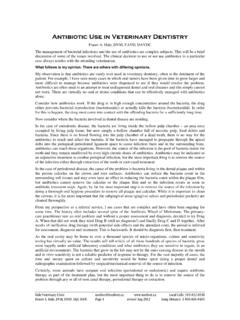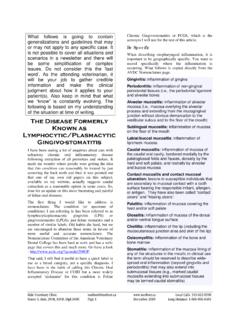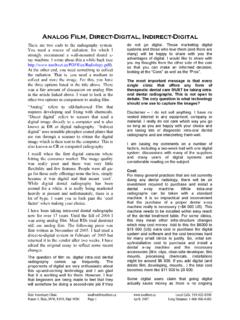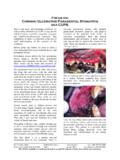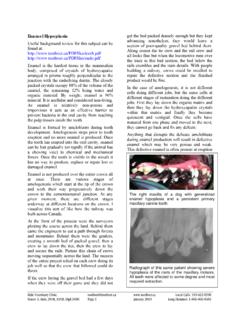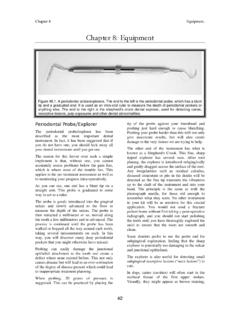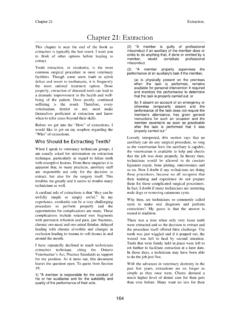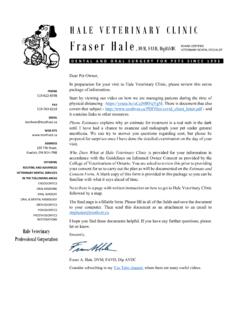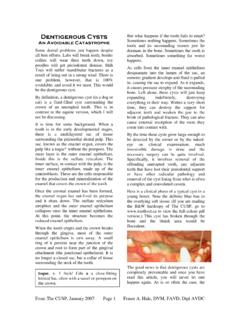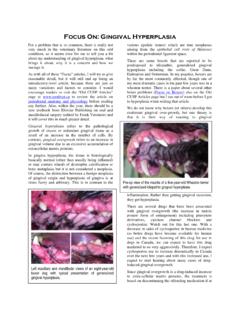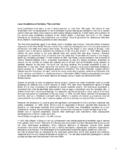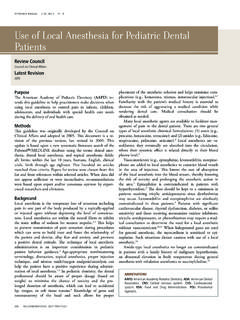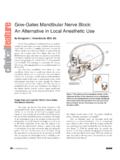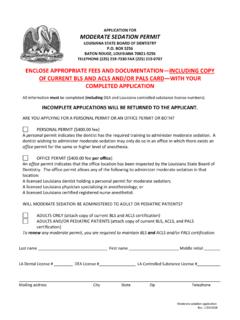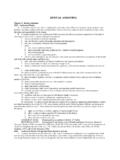Transcription of Local Anesthesia in Veterinary Dentistry - Fraser Hale
1 Hale Veterinary Clinic From The CUSP, July 2007 Fraser Hale, DVM, FAVD, DAVDC Local Anesthesia in Veterinary Dentistry There are two excellent articles (way better than this one) that you may also want to access. In fact, I highly recommend that you order the appropriate back-issues to get these articles ( ). Lantz GC. Step-by-Step Regional Anesthesia for Dentistry and Oral Surgery. J Vet Dent 20(3), pp 181 186, 2003. Beckman BW. Foundations Pathophysiology and Management of Surgical and Chronic Oral Pain in Dogs and Cats.
2 J Vet Dent 23(1), pp50 60, 2006. Two other excellent resources would be the Veterinary Anesthesia Support Group ( ) and the Anesthesia & Analgesia discussion board on the Veterinary Information Network ( ). It has long been established that pain is far easier to control preemptively rather than reactively. That is, if you block a nerve prior to traumatizing the tissue down-stream , there is far less post-operative pain than if you do the surgery and then deal with the pain later.
3 Also the plane of Anesthesia required to keep a patient still depends on the level of stimulation the patient perceives. A light plane may be sufficient for minor scaling and polishing, but would not do for a surgical extraction. In many dental practices, it is routine to use Local Anesthesia for invasive dental procedures to reduce the plane of general Anesthesia required intra-operatively and the amount of pain post-operatively. I have been using bupivicaine with epinephrine (Marcaine E ) to block infra-orbital and mandibular nerves for any procedure likely to cause pain (extractions, root canal, periodontal flap ), and I have been very pleased with the results.
4 The blocks are easy to place, we can maintain patients at a much lighter plane of Anesthesia and their recovery is very smooth and comfortable. There are a number of questions yet to be answered about dental/oral nerve blocks such as: what is the onset and duration of action in cats and dogs for the various agents? in cats and small dogs, is a high volume/diluted bolus better than a low volume/high concentration bolus? when doing bilateral mandibular blocks in cats, is there the potential to cause laryngeal paralysis?
5 (I have never seen evidence of this.) how much is enough? can you block the second maxillary molar with an infra-orbital block? These questions, and others, will be answered in the coming months/years. For now, I want you to know that Local Anesthesia has found a home in Veterinary Dentistry . This is good news, especially for those clients who are nervous about general anesthetic. Every patient still needs a pre-anesthetic assessment and judicious use of anesthetic agents, but now we have one more tool to reduce the risk of anesthetic problems and to ease the degree of post-surgical pain.
6 Properties and Characteristics of Local Anesthetics Used in Veterinary Dentistry Local anesthetic agents are weak organic bases and their penetration in tissue is impaired in acidic environments, as found in areas of infection or abscessation. Therefore, Local nerve blocks are contraindicated in areas of infection and abscessation, as they will not work but may result in inoculation of infection into deeper tissues. The more basic amide agents (lidocaine, mepivicaine, bupivicaine) have a faster onset of action and give more profound analgesia than the ester agents (procaine, propoxycaine, benzocaine).
7 The amide agents also have longer duration of action due to protein binding and are less likely to result in allergic reaction than the ester agents (in humans at least). Amide agents are metabolized by the liver while ester agents are metabolized in the circulation. All Local anesthetic agents in use today cause vasodilation, which increases systemic absorption and decreases duration of effect. To counter this, a vasoconstrictor such as epinephrine is often added.
8 This decreases rate of systemic absorption (reducing risk of systemic toxicity), increases duration of action and decreases Local hemorrhage. Vasoconstrictors may lead to serious side effects including tachycardia and arrhythmias (epinephrine and halothane are a bad combination for this). Bronchospasm may result due to allergic reaction to sulfites added to vasoconstrictor-containing solutions as antioxidants. Epinephrine can potentiate seizures if injected intra-vascularly.
9 Duration of effect has been well documented in humans, but is still a matter of conjecture and extrapolation in dogs and cats. The chart below shows the duration of pulpal and oral soft-tissue analgesia in humans in minutes for various agents. Hale Veterinary Clinic From The CUSP, July 2007 Fraser Hale, DVM, FAVD, DAVDC Agent Pulp Soft tissue Lidocaine with epinephrine 60-90 180-240 Mepivicaine with levonordefrin 45-75 120-240 Etidocaine with epinephrine 45-240 240-540 Bupivicaine with epinephrine 45-240 240-540 Visit to register for the premier Veterinary dental conference.
10 Onset of action for bupivicaine has been reported to be anywhere from 3 to 30 minutes. In my experience, I feel I see onset of action by ten minutes in most cases. Duration of analgesia in dogs and cats with bupivicaine and epinephrine may be as much as 6 to 8 hours as in humans, but more research is needed. Landmarks for Local Dental Nerve Blocks In human, canine and feline patients, there are six basic dental nerve blocks, all of which block sensory branches of the trigeminal nerve.
